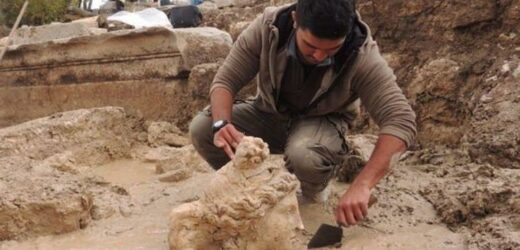Roman Tunisia settlement archaeology is 'enigma' says expert
We use your sign-up to provide content in ways you’ve consented to and to improve our understanding of you. This may include adverts from us and 3rd parties based on our understanding. You can unsubscribe at any time. More info
The team found the pair of statue heads of the goddess of love and the god of wine-making during a dig in the ancient city of Aizanoi, in western Turkey. The two were fittingly found within close proximity of each other. It comes after an earlier dig had found two headless bodies.
Archaeologist Gokhan Coskun said: “These are important findings for us, as they show that the polytheistic culture of ancient Greece existed for a long time without losing its importance in the Roman era.
“The findings suggest that there may have been a sculpture workshop in the region.”
The ancient city of Aizanoi has a rich history filled with ancient Greek and Roman period settlements.
The earliest settlements in the area date back as early as the second millennium BC.


But many of its remaining ruins date to the Roman Empire, including its Roman baths, Zeus temple and macellum, or Roman indoor market.
Archaeologists found the Roman-era heads of Aphrodite and Dionysus buried in a creek bed in the ancient city.
Each head is made of limestone, with Aphrodite’s head measuring 19 inches (50 centimetres) and Dionysus’ head measuring 17 inches (45 cm) tall, according to reports.
Aphrodite, or Venus, was particularly important to ancient Rome.
The goddess of love symbolised “Rome’s imperial power,” according to the J. Paul Getty Museum.

They added: “Venus’s first temples were erected in Rome during the 200s BC to solicit her assistance in battles, and individual leaders later allied themselves with the deity.
“Julius Caesar and his heir, Augustus, forged particularly explicit ties to Venus, claiming descent through her son, the Trojan hero Aeneas.”
It’s unknown how the statues’ heads became separated from their bodies.
According to Greek mythology, Aphrodite is the goddess of love and beauty, and Dionysus was the god of wine and ecstasy.
DON’T MISS
Solar storm warning as sunspot ‘bigger than Earth’ appears ‘crackling’ [REVEAL]
La Palma landslide ‘could kill millions of people’ [INSIGHT]
Egypt breakthrough after ‘find of a lifetime’ uncovered [REPORT]

In Roman mythology, the gods were known as Venus and Bacchus, respectively.
And some even believe the pair “had a grand love affair,” which make their discovery even more amazing.
Previously, archaeologists in Aizanoi also uncovered the statue of Hygieia, a goddess of health, cleanliness and hygiene.
Hygieia is the personification of health, cleanliness and sanitation and is often depicted with a serpent wrapped around her arm or torso and a cup or chalice in her hand.

Mr Coskun told the Greek Reporter: “Unfortunately, (the head) hasn’t survived to the present day, but in its current form, we can see that this statue is about the size of a human.
“During past digs in Aizanoi, finds related to Hygieia were also found.
“This situation makes us think that there may have been some construction and buildings related to the health cult in Aizanoi during the Roman era.
“We’re trying to reveal the columned galleries on the west and south wings of the agora (bazaar) and the shops right behind them.”
Source: Read Full Article


